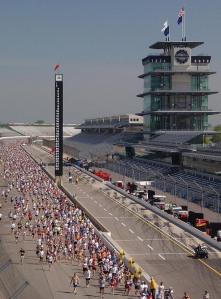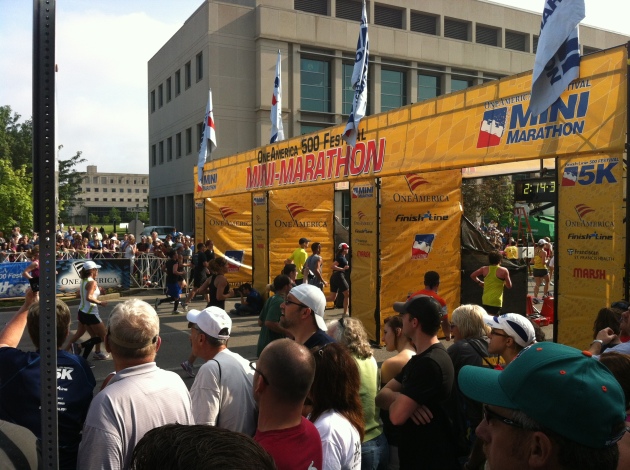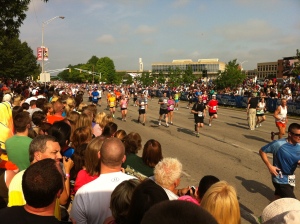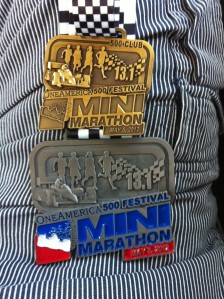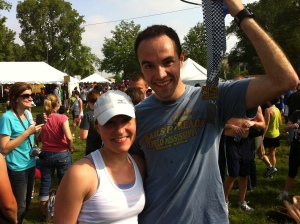I give up, really, I do. At this point, I can do nothing else but admit outright that I don’t know what I’m doing. After five years and twenty-seven marathons, countless different training plans and goals, I finally learned that the sport is too varied and unpredictable to truly harness. Some people, like super-human Michael Wardian or the indefatigable Chuck Engle have managed to tame the marathon, the latter of whom has run up to 25 a year averaging under 3 hours each.
But I am not Chuck Engle.

2014 Indianapolis Monumental Marathon Google Earth Rendering
I’m sorry, this might sound a little melodramatic, so let’s back up and explain things. Four weeks ago, I tried to run two marathons in one weekend. Though I ran the first one in 3:37, I had to drop to the half marathon for Sunday’s race because of an intense pain in my right knee. I spent the rest of the month nursing that injury, keeping the pain at bay while still logging enough miles to stay fit. However, I couldn’t run more than 12 miles a week without taunting fate. I had signed up for the 2014 Indianapolis Monumental Marathon earlier in the year in hopes of attacking my 20-month old marathon PR. But as the month went on with not a single long run, my expectations gradually fell.
I stood in the middle of downtown Indianapolis, thrilled to be huddled with several thousand other runners. Icy winds were slicing through the city, channeled by buildings and making their way into my clothes. I shuffled my feet while blowing warm air into my gloves and checking my watch. I had not layered up so much for a marathon since my first run in 2009. A few crowded blocks away was Ryan, who ran his first half marathon in Shiprock, New Mexico, looking to improve his time on a flatter, less arid course.

Mile 1 – 4 and 25 – 26.2 took place in the city
The first five miles wind in and out of Indianapolis, under bridges and several tunnels. We were given wide, four-lane roads for those opening miles, giving runners plenty of room to find their pace. From the very start, I was hyper aware of every last sensation pulsing through my legs. For the first four miles, as we ran around the obelisk at Monument Circle, past University Park and the Middle Eastern stylings of the Murat Shrine center, everything felt fine. I paid attention to every meaningless sensation to see if it was the advent of pain, but as long as we were in the city, I felt strong.
Until I wasn’t. That tiny, yet familiar tingle of discomfort emerged just past mile 4. It wasn’t a sharp pain or a dull grinding, but a deep tickle, like tennis elbow. I kept running hoping that it would just be an echo, but it lingered. My heart sank and I shook my head. I didn’t think it would happen so early in the race. Four miles in and my right knee had begun to fail me? How would the remaining twenty-two miles feel?
By 10k we were out of the city and running through leaf-draped neighborhoods. I had warmed up quickly, but the wind was still in my face and I had decided to keep my hat and gloves. My leg was tingling with each step, but the pain was manageable and for several random stretches, nonexistent. I alternated between surprised confidence and renewed panic as the discomfort would return. Up ahead the half marathoners split from the crowd and I seriously considered making that left turn. I could run a half marathon and call it a day with no one calling me out. But this was my last race of the year and dropping to half the distance was how my last race ended. I didn’t want this to become a pattern, regardless of how it might benefit my legs. So I stayed with the marathon crowd running next to Fall Creek, further into the city neighborhoods.

The Indianapolis World War Memorial on the right
As I reached mile 10, I noticed a shift. The pain had moved like a worm from my knee to my hip. I had never felt this before. Countless times I’ve read about runners having hip injuries and I’ve never understood what it meant until now. Every push from my leg revealed a tightness on my right side, as if my groin were made of dry plaster, but I was happy to have my mind off my knee. It was a masterwork in mental legerdemain, willing myself to focus on my hip to avoid facing a rebellious knee.
We continued running through beautiful neighborhoods with small pockets of spectators cheering at every corner. Just past halfway, we ran deeper into Indianapolis’ residential tapestry, briefly next to the White River. I was starting to feel small knots in my left calf, and a few miles later, I felt my right patella begin to falter. It took one walk break during an aid station to learn that I had to keep moving. Forward motion was, for now, the only thing keeping my body from buckling, and even the shortest respite would flood my legs with lead and pain.
The only significant hill in the entire course was run southbound on Meridian Street around 25k. I scaled it easily and continued running with the flow of traffic. The wind was ripping sunburnt leaves from trees, adding a new, dry coat to the packed, paste-like layer of brown on the pavement. We ran through Butler University’s campus, along the Crest Hill Cemetery and past the Indianapolis Museum of Art before taking a highway ramp downward to a thin path. By this point, I had either loosened up completely or my body was drunk on adrenaline because the only pains coursing through me were coming from the bottoms of my feet.
I had kept a couple within my sights for several miles. He was wearing a black sleeveless t-shirt and she was in a hot pink singlet. It took me another mile to reel them in, where I tucked myself behind them to block some of the wind. We were running east on Burdsal Parkway, just past 35k and under an orange canopy, when I heard her tell him to go on ahead. I pursued him as he accelerated, dropping his friend. The sun had been out for about an hour and a nearly cloudless sky watched over us. I was barely sweating, running easily in freezing temperatures but I could still feel the sting of the headwind pushing on me.

“The End” Burger at Bru Burger Bar
I began a conversation with Mr. Sleeveless through quick breaths. It was his fourth marathon and he was feeling excellent. I told him that if by mile 22 he felt great, then he was in good shape to earn a shiny new personal best. He just had to keep his focus and make it happen. He decided to use me as a pacer and locked his pace with mine. A mile later, we passed Ivy Tech Community College, whose classic, Greek architecture could have been one of the many monuments that graced this marathon’s course.
I didn’t realize it until a sharp right turn onto Meridian Street, but I was completely focused. Aside from the brief chat with Sleeveless, I was running with tunnel vision, blinders on both sides of my head, staring squarely ahead, watching the course and nothing else. Because after that turn I saw the skyline rising above a blue backdrop, as if from nowhere. Had I turned my head at any point in the last mile I might have seen it earlier, but I was laser-focused on the next three steps. With the city up ahead, I could smell the finish line, hidden somewhere among the buildings. That’s when I reached mile 24 and glanced at my watch.
“Oh, shit,” I said aloud. My eyes widened, I felt an emptiness in my stomach and I surged ahead.
I left Sleeveless behind. Several reflective storefront windows confirmed that I was running alone, using a helpful tailwind to pass slower runners. The time for keeping it together was over. Just two miles removed from the finish line, it was time to empty the reserves. I stomped on the pavement, breathing through my teeth, feeling each step grind my feet to mush. I pumped my arms and kept going, skipping the last two aid stations and passing mile 25. I glanced at my watch again.
Oh come on
The course veered right and a volunteer with a megaphone belted that we had two turns left. I did not let up, keeping my legs moving faster than ever, pushing air out of my lungs, my fists practically punching my chest. The faint echo of the finish line grew louder with every person I pushed behind me. With just a half mile to go, I couldn’t help but smile. As long as I kept moving like this, I felt great. I knew that just past the finish line, I would be consumed by pain, wincing at even the slightest movement. But for now, as I scorched the path like a shark, rushing ahead in constant movement, obeying that base instinct to just – keep – moving, loving every second of it, I felt amazing.

Ryan and I, finishers at Bru Burger Bar
At the risk of sounding supercilious, I couldn’t help but feel that this was my Sammy Wanjiru moment. He set the marathon world on fire in the summer of 2008 by winning the warm, humid Olympic Marathon in Beijing in absolutely fearless fashion. He held the half marathon world record and by October of 2009 had won the London and Chicago Marathons. Back in Kenya, his newfound fame and fortune had plagued him with problems. Famously profligate, he squandered a lot of money on gifts for friends and enormous bar tabs. This prodigal lifestyle took its toll on his training, and when he arrived in Chicago on October 2010 to defend his title, few experts put their money on him.
But what happened on that warm Chicago morning would go down as one of the greatest duels in the modern marathon. Wanjiru traded leads with his Ethiopian rival, Tsegaye Kebede (who took bronze at the 2008 Beijing Olympic Marathon) all the way to the Roosevelt Street bridge. His final surge came just a minute before crossing the finish line and defending his title. No one would have predicted a great performance from him, but somehow, through magic or a ravenous hunger for it, he made it happen.
The parallel is not airtight for many reasons (including his untimely and mysterious death) but part of me could hear Toni Reavis’ avuncular voice chortling about my surprising performance with shock and awe.
Because despite running a maximum of 12 miles a week since October 5; despite having a persistent IT band injury in my right knee that no amount of stretching could exorcise; despite starting this race with my confidence at record low levels and my head elsewhere, I reached the finish line of the 2014 Indianapolis Monumental Marathon intact, having miraculously and imprudently pulled out of my ass a 3:22:14 personal best.

2014 Indianapolis Monumental Marathon Medal, the first of a 4-year series that come together to make a large frame.
And because of all this, I have given up on understanding what puts together a solid marathon training plan. I’ve done the traditional 20-miler three weeks before, sometimes adding or removing a week. I’ve skipped out on 20 in favor of a faster 16-miler, I’ve increased my mileage, favored speed over distance, opted for distance over speed — you name it. But the fact remains that my newly minted PR happened after a persistent injury, and four weeks of spinning classes with absolutely minimal running. I just don’t get it. All signs pointed to disaster, yet I made it happen. From now on, I guess I’ll just run and leave the thinking to sports scientists.
But I was right about the finish line. Three steps after crossing the timing mats, my legs became encased in concrete and each joint felt swollen to twice its normal size. My knees, hips, feet, and even my Achilles tendons were aching. But as you might imagine, I was far away, stuck between pride and confusion, elation and wonder. I limped all the way to the hotel, where I showered and changed at a sloth’s pace before going to Bru Burger Bar with Ryan, who was enjoying equal success, having earned himself a 1:54 half marathon PR.
As I bit into a juicy burger fittingly named “The End,” I reflected fondly on the race and the season. The goal was always to come to Indianapolis to bring down my personal best. I had spent months visualizing it. But that morning, I was certain that I was doomed. I’m still not sure how it happened (or the more tantalizing concern of how much faster I could have run if I had been completely healthy) but it did. Maybe my legs were the right amount of fresh and rested after an entire year of nonstop training. Or perhaps my desire for redemption stopped the pain signals from reaching my brain. Either way, that’s one minute closer to Boston.
Not a bad way to end the season, I thought. We paid the tab and I winced back to the car as every single part of my legs screamed in pain. Not bad at all.

 After a moment of silence in memory of those killed in Paris the night before, the organizers gave thanks to the veterans in the crowd, who gathered to greet and salute each other just ahead of the start line. The town’s cherubic mayor gave a few words of encouragement and the starting cannon thundered through the air, releasing about 450 runners into the town’s sleepy streets.
After a moment of silence in memory of those killed in Paris the night before, the organizers gave thanks to the veterans in the crowd, who gathered to greet and salute each other just ahead of the start line. The town’s cherubic mayor gave a few words of encouragement and the starting cannon thundered through the air, releasing about 450 runners into the town’s sleepy streets. And before I knew it, I was back to overthinking the result without really savoring the fact that Berlin had been a fluke, not Fargo. Despite the hills and short ramp-up, I ran within striking distance of a time I had suspected was an outlier I might never again approach. But now I’ve added a new time to the sample, adding a companion to the statistical improbability. Maybe the 3:17 is my new normal, like 3:26 was three years ago or 3:40 in 2011. Sure, it wasn’t the BQ I had declared I would earn at the start of the year, but it is an indication that I’m moving the standard in the right direction. My goal is still to achieve that Boston mark, but it won’t be done in large, magical improvements, but instead with steady, incremental change.
And before I knew it, I was back to overthinking the result without really savoring the fact that Berlin had been a fluke, not Fargo. Despite the hills and short ramp-up, I ran within striking distance of a time I had suspected was an outlier I might never again approach. But now I’ve added a new time to the sample, adding a companion to the statistical improbability. Maybe the 3:17 is my new normal, like 3:26 was three years ago or 3:40 in 2011. Sure, it wasn’t the BQ I had declared I would earn at the start of the year, but it is an indication that I’m moving the standard in the right direction. My goal is still to achieve that Boston mark, but it won’t be done in large, magical improvements, but instead with steady, incremental change.













